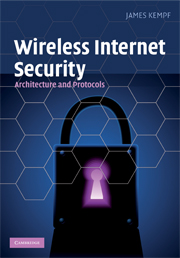Book contents
- Frontmatter
- Contents
- Preface
- Acknowledgements
- 1 Security basics
- 2 Network system architecture basics
- 3 Cryptographic algorithms and security primitives
- 4 Wireless IP network access control
- 5 Local IP subnet configuration and address resolution security
- 6 Security for global IP mobility
- 7 Location privacy
- References
- Index
3 - Cryptographic algorithms and security primitives
Published online by Cambridge University Press: 06 July 2010
- Frontmatter
- Contents
- Preface
- Acknowledgements
- 1 Security basics
- 2 Network system architecture basics
- 3 Cryptographic algorithms and security primitives
- 4 Wireless IP network access control
- 5 Local IP subnet configuration and address resolution security
- 6 Security for global IP mobility
- 7 Location privacy
- References
- Index
Summary
Wireless security is built on a collection of cryptographic algorithms and security primitives providing the algorithmic underpinnings for the security services and supporting systems discussed in Chapter 1. The same algorithms that are used for wireless security are also used for Internet security in general. The differences primarily stem from how the algorithms are used in wireless and mobile Internet systems, which is the topic of future chapters. In this chapter, we review security algorithms and primitives that are common to both wireless security systems and Internet security systems in general.
Much of the material in this chapter is available from other sources in more detail than presented here. The material here is intended to present an overview of the cryptographic algorithms and security primitives commonly found in wireless Internet security systems. Before selecting an algorithm for design work, however, a more complete reference should be consulted. It is particularly important that the vulnerabilities of the algorithms are well understood. Uncompensated weaknesses or algorithms that are used in an inappropriate manner may result in opportunities for attack. Detailed information about the cryptographic algorithms and security primitives discussed in this chapter can be found in the books (Menezes, Oorschot, & Vanstone, 1997) and (Kaufman, Perlman, & Speciner, 2002). In addition, Wikipedia is an excellent reference on different cryptographic algorithms, for example (Wikipedia, 2008b) on the RSA public key algorithm. Wikipedia pages can be found simply by searching online in Wikipedia using the algorithm name as the key.
- Type
- Chapter
- Information
- Wireless Internet SecurityArchitecture and Protocols, pp. 35 - 56Publisher: Cambridge University PressPrint publication year: 2008



